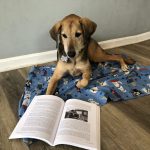When your cute little puppy isn’t acting so cute anymore
You thought you did everything right. You took your puppy to puppy class. You introduced them to a lot of people (or as many as possible during the COVID quarantine). They played with other puppies on the block. So why does it seem as though your puppy is not listening to basic cues all of sudden? When did they become afraid of going into the pet store? Why are they barking at the dog across the street on walks?

Guess what, your puppy is a teenager!
When does adolescence start? Well, that depends. Smaller breed dogs usually mature faster and adolescence can hit anywhere from five months to eight months old and lasts until your puppy is ten to twelve months old. For larger breed dogs, it can start at six to ten months old and end around twelve to eighteen months old. “Wait, it’s how long?!” You can get through this! How? By being consistent and using force-free techniques to reinforce the behaviors you want. Let’s break it down.
Don’t think of it as training but rather teaching your dog basic manners. Portion out your dog’s food and use it to reward the good behaviors you observe. Your dog is laying down while you’re watching television? Reward! Your dog sits while you prepare coffee? Reward! Your dog checks in with you while walking? Reward! Your dog keeps all four paws on the floor when you enter the room and greet them? Reward! You get the idea. Instead of focusing on what you don’t want them to do, focus on the good they are doing.
Remember that puppy socialization?
Socialization is not just puppies playing with other puppies. It is also introducing your puppy to different objects, people and experiences. When your dog becomes an adolescent, they enter a second flight impact stage. This means that a frightening experience (such as thunderstorms, fireworks or a scary interaction with another dog) could have a lasting impression. Below is a great checklist from the Pet Professional Guild to help with socialization.
Free Puppy Socialization Checklist
Let’s use the “invisible” fence as an example. Your dog sees their best friend and their owner on the sidewalk in front of the house. They run up to say, “Hi”. Instead of a pleasant experience, they get shocked (or at minimum will receive a warning beep they will be shocked). They now associate seeing their best friend and their owner with being shocked. Since this is a formative stage in your dog’s life, it will be a long road to overcome the fear of being shocked at seeing the other dog and person. This is why we use force-free methods instead of “tools” and recommend all new interactions (and those already experienced) are pleasant.
What to do next?
Keep working with your dog to reward their good behaviors. When they do something good, reward them! When you introduce something new and they are curious, reward them! Be sure to be consistent and don’t punish them if they do something you don’t like. Instead, have them do something else your want. If they are barking at a dog on your walk, turn them around and get them focused on you.

As always, reach out to us or another qualified force-free trainer if you would like help getting through your dog’s teenager stage or if you would like a consultation for any other reason. Remember, your dog is still a puppy during their teenager months and most importantly, let them be a dog!
Laura Schleef is the Owner and Head Trainer at the Doggie Depot of Virginia. When not training or playing with other people’s dogs, you can find her snuggling with her Border Collie mix Rocky and keeping her German Shepherd/Beagle cross Gidget from trying to eat all of Rocky’s treats. She has been training dogs in multiple capacities for over 15 years and finally quit her “day job” in 2016 to pursue her passion full-time. In addition to shadowing other trainers, Laura has received certifications through Karen Pryor and Dr. Ian Dunbar force-free training programs.


